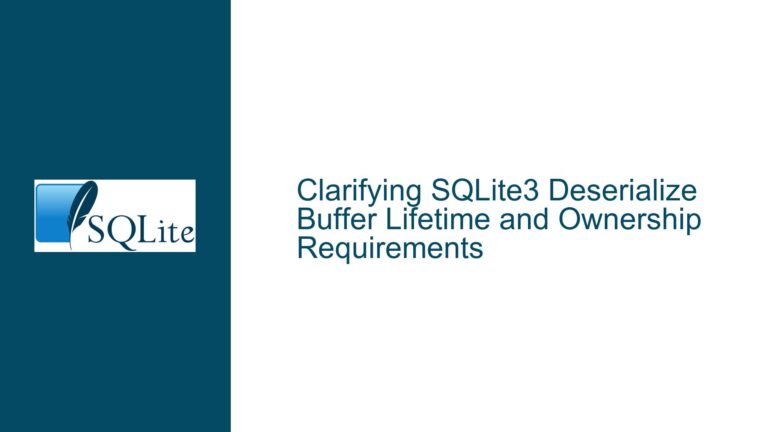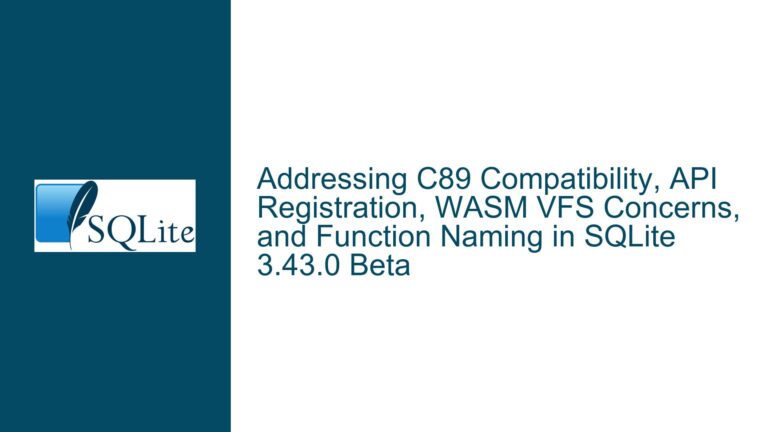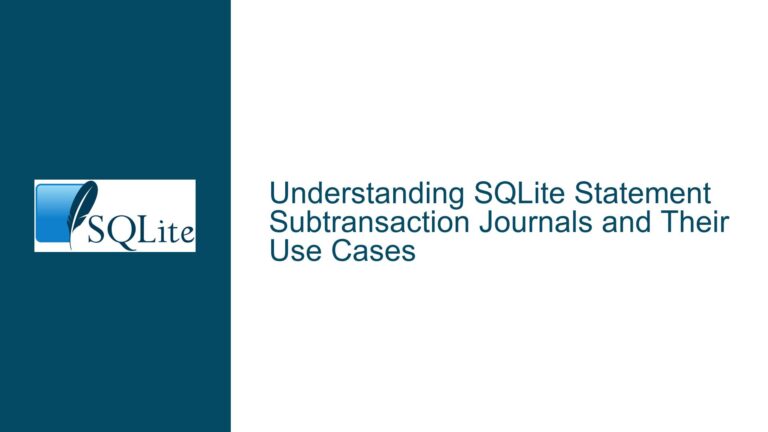Assertion Failure in rtreeDeleteRowid Due to Invalid R-Tree Rootpage Configuration
R-Tree Virtual Table Corruption Triggered by Manual Schema Modification
Issue Overview
The assertion failure pLeaf!=0 || rc!=SQLITE_OK || CORRUPT_DB in the rtreeDeleteRowid function occurs when SQLite attempts to delete a row from an R-Tree virtual table after manual tampering with the sqlite_schema table. The error manifests during an UPDATE operation that modifies the R-Tree’s spatial data column. The root cause lies in invalid structural metadata for the R-Tree table, specifically an incorrect rootpage value forced via direct sqlite_schema modification. R-Tree virtual tables rely on precise coordination between their internal data structures (stored as shadow tables) and metadata in sqlite_schema. When the rootpage value is manually set to an arbitrary integer (e.g., 3), the R-Tree module’s node traversal logic fails to locate valid leaf nodes during deletion, triggering the assertion. This scenario exposes a critical dependency between schema integrity and R-Tree’s internal indexing mechanics.
Invalid Rootpage Assignment and R-Tree Node Traversal Failure
Possible Causes
The assertion failure arises from three interdependent factors:
Direct Manipulation of
sqlite_schema.rootpage:
TheUPDATE sqlite_schema SET rootpage=3command forcibly changes the root page of the R-Tree’s primary data structure. R-Tree virtual tables internally manage multiple shadow tables (e.g.,%_node,%_parent,%_rowid), where therootpageinsqlite_schemapoints to the initial node of the spatial hierarchy. Arbitrarily setting this value to 3 creates a mismatch between the R-Tree’s expected node hierarchy and the actual database pages.Violation of R-Tree Page Initialization Protocol:
R-Tree virtual tables initialize their root page during creation viartreeCreateand subsequent node allocation routines. Manually overridingrootpageskips this initialization, leaving the R-Tree module with a root page that lacks valid node headers, cell counts, or child pointers. During deletion operations, thertreeDeleteRowidfunction traverses the tree from the root page. An invalid root page causes traversal logic to dereference corrupt data or non-existent pages, leading topLeaf=0(no leaf node found) andrc=SQLITE_OK(no error reported due to corrupted control flow).Interaction with
.testctrl n 4:
The.testctrl n 4command activates internal testing controls that alter page allocation strategies or disable certain consistency checks. While its exact effect is undocumented, it likely exacerbates the problem by allowing the R-Tree to operate with incomplete or malformed structures. This command may suppress normal error recovery mechanisms that would otherwise detect the invalid root page earlier.
Repairing R-Tree Metadata and Resolving Assertion Conditions
Troubleshooting Steps, Solutions & Fixes
Step 1: Diagnose Schema and R-Tree Structural Integrity
Execute PRAGMA integrity_check; to identify low-level database corruption. In this case, the check will report inconsistencies in the R-Tree’s shadow tables due to the invalid root page. Use PRAGMA page_size; and PRAGMA page_count; to verify that page 3 exists and is part of the database file. If the database is newly created, page 3 may not correspond to an R-Tree node (it could be part of the schema table or freelist).
Step 2: Reconstruct R-Tree Metadata Without Manual Overrides
Avoid direct modification of sqlite_schema for virtual tables. Instead, drop and recreate the R-Tree table using standard DDL commands:
DROP TABLE t0;
CREATE VIRTUAL TABLE t0 USING rtree(c, a, b);
This ensures proper initialization of shadow tables and root pages. If the use case requires testing invalid configurations, consider using SQLite’s internal APIs (e.g., sqlite3_test_control) instead of raw SQL updates to simulate corruption.
Step 3: Analyze R-Tree Node Allocation Patterns
Enable SQLite’s internal tracing for R-Tree operations by compiling with -DSQLITE_ENABLE_RTREE_DEBUG and executing .rtree_check t0 before and after schema modifications. This command validates the R-Tree’s internal consistency, including parent-child linkages and cell counts. After setting rootpage=3, .rtree_check t0 will report missing or malformed nodes.
Step 4: Modify the Test Case to Avoid Undefined Behavior
The original test case combines unsafe schema edits with R-Tree operations. To reproduce the issue without assertions, replace the manual rootpage update with a controlled method of inducing corruption:
-- Use SQLite's corruption injection API (if available)
SELECT sqlite3_corrupt('main');
Alternatively, use a hex editor to modify the root page pointer in the database file. This approach isolates the issue from schema manipulation side effects.
Step 5: Patch SQLite to Handle Corrupt R-Tree Pages Gracefully
In debug builds, assertions enforce internal invariants. In production builds, SQLite returns SQLITE_CORRUPT instead of crashing. Modify rtreeDeleteRowid in ext/rtree/rtree.c to replace the assertion with error handling:
if( pLeaf==0 && rc==SQLITE_OK && !CORRUPT_DB ){
return SQLITE_CORRUPT;
}
Rebuild SQLite with this patch to convert the assertion into a recoverable error.
Step 6: Validate Compilation Flags and Testing Controls
The use of .testctrl n 4 may disable critical sanity checks. Re-run the test case without this command to see if earlier errors surface. Additionally, review SQLite’s change logs for commits related to R-Tree node deletion and sqlite_schema handling. The failure may correlate with recent changes in transaction handling or page validation.
Final Fix:
The definitive solution involves refraining from manual sqlite_schema updates for virtual tables. If schema manipulation is unavoidable, use sqlite3_db_config with SQLITE_DBCONFIG_DEFENSIVE to block direct writes to schema tables. For testing purposes, leverage SQLite’s built-in corruption simulation functions instead of raw updates. Always rebuild R-Tree virtual tables after schema alterations to reinitialize internal metadata.






